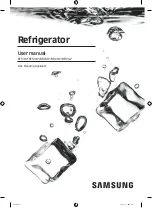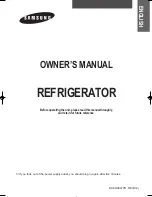
9
Unpacking
• Remove all packing materials.
• Check attachments and materials
• Checking should be conducted with reference to the Packing
List. Contact the local distributor if discrepancies are found.
• Ensure proper location of the refrigerator.
• Make sure the refrigerator is kept upright during handling.
If an inclination is required, it should not exceed 45 degrees.
Otherwise the appliance may get damagedresulting not only
in compromised refrigeration performance.
• To avoid product damage or personal injury, the refrigerator
should be unpacked by two pesons after it is located in a
previously selected position.
• Before installation,make sure the refrigerator has no visible
exterior damage. *When handling the refrigerator, do not
lift it by holding the worktop, to prevent any damage to the
refrigerator.
• Do not start up a refrigerator that is damaged.
• Clean the refrigerator before use.
• After the refrigerator has been sited and cleaned, let it stand
for more than 30 minutes before connecting the power
source
Starting the refrigerator
After connecting to the power supply, turn the temperature con-
troller clockwise from position OFF to any position between 1 and
6 to start the refrigerator. The refrigerator compressor will stop
when the temperature controller is at position OFF.
Adjusting the temperature:
The temperature inside the refrigerator is adjusted by turning
the temperature controller. Positions 1 to 6 represent different
temperatures from the lowest to the highest.
Appliance switched off - OFF setting
Minimum temperature - 1 setting
Optimal temperature - 2-5 setting
Maximum temperature - 6 setting
Caution: Some time will be required for the refrigerator to reach
the set level when temperature adjustments are made. The
length of this period is determined by difference in the existing
and set temperatures, the ambient temperature, the frequency
with which the door is opened and closed and the amount of
food in storage.
Loading the refrigerator with food
When the refrigerator is switched on, do not load food until 1~2
hours have passed.
Usually, food for cold storage or deep freezing can be loaded
when the temperature inside the compartment reaches the set
point.
Instructions
Cold storage is for short-term food storage or for daily con-
sumption.
Although the temperature in most parts of the cold storage
compartment can be regulated between 0 and 10 degrees Cen-
tigrade, extended periods of food storage is not recommended.
Cold storage should only be used for short-term storage.
• Hot food must be cooled to room temperature before storing
in the refrigerator
• Dry any water droplets on the food before placing it in the
refrigerator.
• It is recommended that food be sealed in suitable storage
bags before being placed in the refrigerator; this will prevent
moisture in the food from evaporating and prevent vegeta-
bles and fruit from withering or altering in flavor.
• Do not store excess quantities or weights of food; food
should be stored with spaces in between for better storage
results. Never overload shelves, as they may collapse under
excessive loads.
• Food to be stored should be sorted according to consumer
requirements. Food consumed daily should be placed in the
most convenient area, this will minimize opening periods for
the door. Do not place food too close to the internal walls.
Food holder cleaning
• Food holders can be taken out for cleaning
Instructions for food storage
• Storage period will be extended if vegetables are placed
with their roots towards the cold source.
• Leaves of carrots or turnips should be removed before stor-
age.
• Put a wad of tissue on the bottle holder before placing bot-
tles on it so that later cleaning is easier
• Onions, garlic, ginger, water chestnuts and other root
vegetables should not be stored in the refrigerator,as these
foods are suitable for long-term storage at normal tempera-
tures.
• Ripe squash, melon, papaw, bananas and pineapples should
not be stored in the refrigerator.Freezing will accelerate the
ripening process.
Defrosting the cold storage compartment
The cold storage compartment is designed for automatic defrost-
ing. Frost formed on the back wall will melt and flow via the
drainpipe to the evaporating container over the compressor on
the back of the refrigerator, where the heat generated by the
compressor will evaporate the water.
Caution: Always keep the drain over the vegetable and fruit tray
clear to ensure the normal flow of defrosted water. Use the rod
provided to clear any blockages.





























